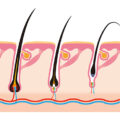Last updated on June 3, 2024
DHI VS FUE; A MARKETING SCAM?
Making the right decision while choosing the right clinic and technique for your hair transplant is very important. The aim is to get a natural-looking result and to protect the donor area from trauma. However, most people are lured into sub-standard techniques created by misleading marketing ploys, based on cost and the number of follicles implanted.
One of the ‘trending’ methods of Hair Transplantation hitting the market is DHI – so it’s no surprise many patients ask about how the DHI technique is better than the FUE technique? This question is surprising as in reality, they are both FUE.
MISCONCEPTION FOR DHI AND FUE FOR HAIR TRANSPLANT
A common misconception is that there are three techniques – FUT (Follicular Unit Transplant) and FUE (Follicular Unit Extraction) and DHI (Direct Hair Implantation). The definition of a hair transplant technique is “how to harvest hair from the back of your head aka Donor Area, to transplant in the problem area, not a hair transplant equipment.” According to the International Society of Hair Restoration Surgery (ISHRS) standard, there are only two techniques for a hair transplant which are FUE and FUT.
To break both of these procedures down, a FUE procedure involves the individual extraction of hair follicles, which are then transplanted elsewhere on the scalp, while a FUT procedure involves removing a long strip of the scalp, separating the follicles, and then transplanting them.
The advantages and disadvantages of each procedure are largely dependent on the patient and their desired outcome, in addition to a number of other factors. A best practice hair restoration doctor will strive to ensure a prospective patient is given comprehensive information about hair loss and treatment options, and whether or not a hair transplant is even possible- whether you choose FUT hair transplant or FUE hair transplant.
A common rule of thumb is that individuals who require a larger number of hair grafts due to more severely thinning hair are better candidates for a FUT procedure, as FUT grafts generally provide a greater yield of follicles for transplanting as well as superior control of the direction of hair growth. FUE transplants, on the other hand, might be better suited for those who only require a smaller number of grafts or those who wish to return to their everyday activities shortly after their transplant, as the recovery time after an FUE procedure is often shorter, due to the procedure being less invasive.
So where does the DHI come in to all this?
The word DHI hair transplant wasn’t imposed by ISHRS; in fact, DHI stands for Direct Hair Implantation, which the method is to extract the follicular unit out one by one like FUE. In the graft placement step, Implanter will be used instead of forceps. In fact, DHI, it classified as FUE – but with a new fancy name attached. In the past this method was called CHOI, which produced very low graft survival rates and had a poor reputation among top hair restoration clinic’s, hence the need for a rebrand.
DHI hair transplant is a marketing term that is referred to as the FUE technique using the Implanter for graft placement steps. Don’t forget that the FUE stands for Follicular Unit Excision (the latest definition by ISHRS), which explains how to take out the hair from the back of the head.To make a long story short: the DHI punch is a tool used on 1 out 4 steps in the FUE hair transplant. Using a smaller punch has no influence on how you implant, therefore, density, angle and design are not affected by the punch diameter. However, the smaller the punch, the worst is the survival rate of your follicular units.
WHY ARE FUE PUNCHES NOT THE MOST IMPORTANT FACTOR IN YOUR SURGERY?
To answer this question, one must go back to the central question: “what makes a successful hair transplant ?”
If the success of your hair transplant is your donor area after the transplant, then, yes, Punches are a key factor.
If the success of your hair transplant is your new hair and your new look, then the punch has very little to do on your hair density, your hair angle and your hairline design.
You must trust your doctor to find the right balance between the punch size and your follicular units characteristics.
If anyone follows us from the beginning, you will already know that we follow the ISHRS guidelines strictly, and we’re against providing false information or fraud advertisement. That’s why our patients can be assured that the information received from us is accurate information according to the international standards.








